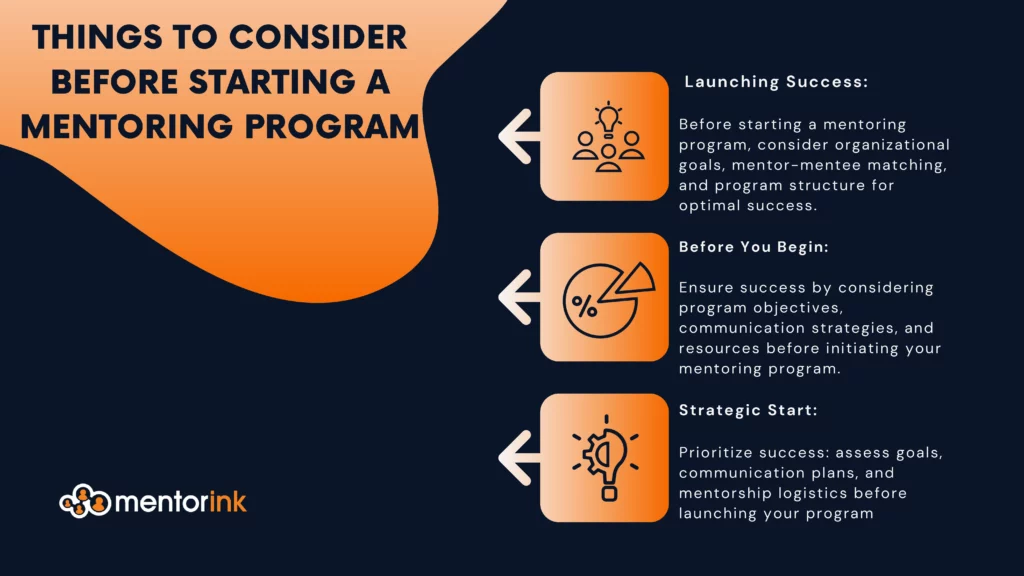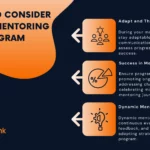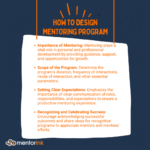
Introduction
Briefly introduce the topic of mentoring programs 💚
It’s important to know things to consider before starting a mentoring program. Mentoring programs are structured relationships in which an experienced individual, known as a mentor, provides guidance, support, and knowledge to a less-experienced individual, known as a mentee. These programs are designed to foster personal and professional growth, skill development, and knowledge transfer. Mentoring can occur in various settings, including workplaces, educational institutions, and community organizations, and it plays a vital role in helping individuals achieve their goals and reach their full potential. In this context, mentoring programs serve as invaluable tools for personal and professional development, offering opportunities for both mentors and mentees to learn, grow, and succeed.
Explain the importance of setting up a mentoring program ℹ
Setting up a mentoring program is crucial as it:
- Fosters skill development and career advancement.
- Facilitates knowledge transfer and learning.
- Boosts employee engagement and satisfaction.
- Promotes diversity and inclusion.
- Enhances organizational learning and leadership development.
- Creates a positive and supportive workplace culture.
Define program goals
Establish the main goals of the mentoring program 🎯
The main goals of a mentoring program can vary depending on its specific objectives and the needs of the participants. However, here are some common overarching goals that mentoring programs often aim to achieve:
- Professional Development
- Skill Transfer and Knowledge Sharing
- Networking and Relationship Building
- Career Guidance and Goal Achievement
- Personal Growth and Confidence Building
- Diversity and Inclusion
- Succession Planning
- Employee Engagement and Satisfaction
- Organizational Learning and Improvement
- Measurable Outcomes
To clarify it’s essential for each mentoring program to define its unique goals and objectives based on the needs and circumstances of its participants and the organization’s mission. Therefore clear and well-defined goals provide a roadmap for program development, participant expectations, and evaluation of success.
Identify target audience
Identify the target audience for the mentoring program ⚖︎
Identifying the target audience for your mentoring program is a crucial step in ensuring that the program effectively meets the needs of its participants. The target audience should be aligned with the program’s objectives and goals. Here are some factors to consider when identifying the target audience for your mentoring program:
- Employee Development Programs:
- New Employees: Mentoring can be valuable for newcomers who need guidance and support during their initial integration into the organization.
- High-Potential Employees: Identify employees with the potential for leadership roles and provide them with mentors to accelerate their development.
- Student Mentoring Programs:
- College or University Students: Mentoring can benefit students by offering career guidance, internships, and academic support.
- High School Students: High school mentoring programs can focus on career exploration, college readiness, or personal development.
- Entrepreneurship and Startups:
- Aspiring Entrepreneurs: Individuals looking to start their own businesses can benefit from mentors who provide guidance on business planning, strategy, and networking.
- Startup Founders: Mentoring can help early-stage startup founders navigate challenges and make informed decisions.
- Diversity and Inclusion Initiatives:
- Underrepresented Groups: Target individuals from underrepresented or marginalized communities to provide them with opportunities for growth and advancement.
- Women in Leadership: Develop mentoring programs to support the career advancement of women in leadership positions.
- Specific Career Fields or Industries:
- Healthcare Professionals: Create mentoring programs for healthcare workers to enhance clinical skills and career progression.
- Technology Sector: Technology mentoring programs can focus on software development, data science, cybersecurity, etc.
- Career Stages:
- Mid-Career Professionals: Offer mentoring to individuals who are at a mid-career stage and seeking guidance on advancement or career change.
- Pre-Retirement: Provide mentoring for employees approaching retirement to help them plan for their next phase of life.
- Youth and Education:
- At-Risk Youth: Mentoring can be instrumental in providing guidance and support to at-risk youth to help them stay on a positive life path.
- Students with Special Needs: Create mentoring programs tailored to the unique needs of students with disabilities.
- Nonprofit Organizations:
- Nonprofit Staff and Volunteers: Mentoring within nonprofit organizations can help staff and volunteers build skills and achieve the organization’s mission.
- Personal Development:
- Individuals Seeking Personal Growth: Offer mentoring for personal development, including areas like goal-setting, time management, and life skills.
- Specific Projects or Initiatives:
- Identify individuals involved in specific projects or initiatives within your organization or community and offer mentoring to support those efforts.
When determining the target audience, consider the program’s goals, the resources available, and the expertise of potential mentors. Thus tailoring the program to the specific needs and characteristics of the target audience will increase its effectiveness and impact.
Develop recruitment strategy
Create a strategy to recruit participants for the program 🧠
Recruiting participants for your mentoring program is a critical step in its success. Therefore a well-planned recruitment strategy ensures that you attract the right mentors and mentees who align with your program’s goals and objectives. Here’s a comprehensive strategy to recruit participants:
- Clarify Program Goals and Benefits
- Identify Target Audiences
- Leverage Existing Networks
- Utilize Online Platforms
- Collaborate with Partners and Stakeholders
- Information Sessions and Workshops
- Create Engaging Marketing Materials
- Networking Events
- Employee Referral Programs (for corporate mentoring)
- Mentor and Mentee Training Sessions
- Clear Application and Matching Process
- Follow-Up and Communication
- Feedback and Continuous Improvement
To explain, by implementing this recruitment strategy, you can effectively engage mentors and mentees who are motivated to participate in your mentoring program and contribute to its success.
Establish mentor/mentee criteria
Determine the criteria for matching mentors and mentees 🎚︎
Matching mentors and mentees effectively is a crucial aspect of a successful mentoring program. The goal is to create mutually beneficial partnerships where both parties can learn and grow. Here are some criteria to consider when matching mentors and mentees:
- Goals and Objectives:
- Ensure that the mentee’s goals and objectives align with the mentor’s expertise and the program’s goals.
- Industry or Field of Expertise:
- Match mentees with mentors who have experience and expertise in the same or related industries or fields.
- Experience Level:
- Consider the experience levels of both mentors and mentees. For example, junior employees may benefit from more experienced mentors, while mid-level professionals might prefer mentors closer to their career stage.
- Skill Set and Knowledge:
- Match based on specific skills or knowledge areas that the mentee wishes to develop or acquire.
- Ensure that the mentor possesses the skills and knowledge the mentee seeks to gain.
- Personal Compatibility:
- Assess personality traits and communication styles to promote a positive mentor-mentee relationship.
- Consider factors such as communication preferences, working styles, and values.
- Availability and Commitment:
- Ensure that both mentors and mentees have compatible schedules and can commit to regular meetings and interactions.
- Diversity and Inclusion:
- Promote diversity and inclusion by considering factors such as gender, race, ethnicity, and background when making matches.
- Ensure inclusivity in the mentoring program to provide opportunities for underrepresented groups.
- Geographic Location (if applicable):
- If the mentoring program involves in-person meetings, match mentors and mentees who are geographically close to each other.
- Specific Interests:
- Common interests can enhance the mentoring relationship and rapport.
- Development Stage:
- Assess where the mentee is in their professional or personal development journey.
- Match mentors who can provide guidance and support at the appropriate stage.
- Communication Preferences:
- Consider how mentors and mentees prefer to communicate (e.g., in-person, virtual, email, phone).
- Ensure that communication preferences align to facilitate effective interaction.
- Feedback Mechanisms:
- Establish a feedback loop for both mentors and mentees to express their preferences and concerns regarding the matching process.
- Be open to adjusting matches if issues arise.
- Mentor Availability for Multiple Mentees:
- In some cases, mentors may be willing and capable of mentoring multiple mentees simultaneously.
- Assess mentor capacity and willingness to mentor more than one mentee if applicable.
Remember that flexibility and open communication are essential throughout the matching process. It may take some time to find the right match for everyone involved, so be prepared to make adjustments if initial matches do not work out. Thus regular check-ins and feedback from mentors and mentees can help ensure that the matching process is successful and leads to productive mentoring relationships.
Select mentoring software
Research and select an appropriate mentoring software 🔍️
Selecting the right mentoring software is crucial for the success and efficiency of your mentoring program. Here are some steps to help you research and choose appropriate mentoring software:
- Define Your Needs:
- Clearly outline your program’s goals, objectives, and specific requirements for mentoring software. Consider factors such as the number of participants, program duration, and budget constraints.
- Research Available Options:
- Conduct online research to identify mentoring software solutions available in the market.
- Consider both general mentoring software and industry-specific options.
- Read Reviews and Case Studies:
- Look for user reviews and case studies to gain insights into the real-world experiences of organizations that have used the software.
- Pay attention to reviews related to ease of use, customization options, and customer support.
- Request Demos and Trials:
- Contact software providers to request demos and trials. This will allow you to get hands-on experience with the software and assess its features and functionality.
- Assess Key Features:
- Evaluate the software’s features to ensure they align with your program’s needs. Key features to consider include:
- User-friendly interface for mentors and mentees.
- Matchmaking and pairing algorithms.
- Communication tools (e.g., messaging, video conferencing).
- Goal-setting and progress tracking.
- Reporting and analytics.
- Security and data privacy features.
- Integration capabilities with other systems (e.g., HR software).
- Scalability:
- Consider whether the software can scale to accommodate your program’s growth, whether that means adding more participants or expanding to new locations.
- Customization:
- Assess the degree of customization the software allows.
- Your program may have unique requirements that necessitate customization.
- User Support and Training:
- Inquire about the level of customer support and training provided by the software vendor. Ensure that there are resources available to help users get the most out of the software.
- Pricing and Budget:
- Obtain detailed pricing information, including any subscription fees, setup costs, and additional charges. Compare pricing with your program’s budget.
- Data Security and Compliance:
- Verify that the software complies with data privacy regulations (e.g., GDPR, HIPAA) if applicable.
- Assess the security measures in place to protect sensitive information.
- User Feedback:
- Seek feedback from potential mentors and mentees to gauge their comfort and satisfaction with the software.
- Vendor Reputation:
- Investigate the vendor’s reputation, including its track record in the industry and customer testimonials.
- Compatibility:
- Ensure that the software is compatible with the devices and operating systems used by your participants (e.g., mobile devices, web browsers).
- Contract Terms and Support:
- Review the terms of the software contract, including licensing agreements, service-level agreements (SLAs), and support options.
- Implementation Timeline:
- Discuss the expected timeline for implementing the software and any necessary training.
- Trial Run:
- Conduct a pilot program or trial run with a limited number of participants to assess the software’s performance in a real-world setting.
- Decision-Making Process:
- Involve key stakeholders in the decision-making process, including program administrators, IT personnel, mentors, and mentees.
Once you’ve gathered all this information, create a detailed comparison matrix to evaluate each software solution based on your program’s specific needs and priorities. Thus this will help you make an informed decision and select the mentoring software that best aligns with your objectives.
Configure software settings
Configure the mentoring software according to program needs ⚙︎
Configuring mentoring software according to your program’s specific needs is a crucial step to ensure that the software aligns with your goals and objectives. Here’s a step-by-step guide on how to configure mentoring software:
- Define Configuration Requirements:
- Review your program’s goals and objectives to identify the specific configuration needs. Consider factors such as the number of participants, the type of mentoring (one-on-one, group, or hybrid), and any unique program features.
- User Registration and Profiles:
- Configure user registration forms to gather essential information from mentors and mentees during the onboarding process.
- Define user profile fields that participants can fill out to provide additional information about their skills, preferences, and goals.
- Matching Algorithms:
- If the software offers matching algorithms, customize them to align with your program’s criteria for matching mentors and mentees.
- Specify the weight or importance of various matching criteria, such as industry expertise, goals, or location.
- Communication Tools:
- Set up communication tools within the software, such as messaging systems, video conferencing, or discussion boards.
- Configure notification settings to ensure participants receive alerts for new messages, meetings, or updates.
- Goal Setting and Progress Tracking:
- Customize goal-setting features to allow mentees and mentors to define specific goals and objectives for their mentoring relationship.
- Enable progress tracking mechanisms, such as regular check-ins or milestone reporting.
- Reporting and Analytics:
- Configure reporting and analytics features to capture relevant data on the program’s performance.
- Define key performance indicators (KPIs) to measure the impact and effectiveness of the mentoring relationships.
- Customization and Branding:
- Tailor the software’s user interface to align with your program’s branding and visual identity.
- Customize email templates, logos, color schemes, and program-specific messaging.
- Security and Data Privacy:
- Implement security measures to safeguard user data and comply with data privacy regulations.
- Configure access controls and permissions to restrict user access to sensitive information.
- Matchmaking Preferences:
- Allow participants to specify their preferences for mentoring, such as whether they prefer one-on-one or group mentoring.
- Configure the software to accommodate different mentoring formats.
- Feedback and Evaluation:
- Set up mechanisms for participants to provide feedback on their mentoring experiences.
- Thus define surveys or evaluation forms to gather insights for program improvement.
- Training and Resources:
- Create training materials or resources within the software to help users navigate its features.
- Provide user guides, tutorials, or video demonstrations as needed.
- Integration with Other Systems:
- If necessary, integrate the mentoring software with other systems used in your organization, such as HR software or learning management systems.
- User Support:
- Ensure that there is a dedicated user support system in place for participants to seek assistance with technical issues or questions.
- Testing and Quality Assurance:
- Conduct thorough testing of the configured software to identify and resolve any bugs or issues.
- Test the software with a small group of participants before rolling it out to the entire program.
- Training and Onboarding:
- Provide training sessions or onboarding materials to mentors and mentees to familiarize them with the configured software and its features.
- Pilot Program:
- Consider conducting a pilot program to validate the configuration and gather feedback from participants for further improvements.
- Continuous Monitoring and Updates:
- Continuously monitor the software’s performance and gather feedback from users to identify areas for improvement.
- Regularly update and fine-tune the configuration based on program needs and participant feedback.
To explain, by carefully configuring the mentoring software to meet your program’s specific needs and objectives, you can enhance the user experience, improve the effectiveness of mentoring relationships, and achieve the desired outcomes for your mentoring program.
Conclusion
Before embarking on the journey of starting your own mentoring program, take the time to carefully consider these factors. Doing so will help you design a program that is well-aligned with your goals and the needs of your participants, ultimately increasing its chances of success and making a positive impact.
Sounds exciting?
We would be very happy to support your design and run your mentoring programs
Book your Demo

